The Heterogeneous Relationship Between China’s Low-Carbon Economic Scale and Quality: A County-Level Analysis from the Perspective of Administrative Division
Abstract
1. Introduction
2. Literature Review
3. Materials and Methods
3.1. Theoretical Background and Hypothesis
3.2. Empirical Models
3.3. Evaluation of Scale and Quality Using Satellite Data
3.4. Data Sources
4. Results and Discussion
4.1. Different Relationship Between Scale and Quality Across Counties and Municipal Districts
4.2. Robustness Checks
4.2.1. Substitute Variables
4.2.2. Omitted Variables
4.2.3. Discussion on Nonlinear Relationship Based on Fixed Effects Panel Regression Analysis
4.3. Explorations on the Potential Reasons
4.3.1. The Different Impacts of Secondary Industry Development and Large-Scale Industrial Development Across Counties and Municipal Districts
4.3.2. The Different Effects of Emission Reduction Technological Progress Across Counties and Municipal Districts Through the Degree of Decoupling
4.3.3. The Different Impacts of Government Intervention Across Counties and Municipal Districts Through the Degree of Decoupling
5. Conclusions and Policy Implications
- (1)
- To mitigate the negative impact of scale expansion on quality growth, counties—particularly those with secondary industry dominance and resource-dependent development models—must prioritize transforming their economic growth patterns. This transformation should emphasize industrial structure optimization and energy consumption restructuring to achieve effective decoupling. Key strategies for transitioning toward low-carbon development include systematically phasing out obsolete production capacities and energy-intensive equipment, with particular attention paid to reducing disproportionate secondary industry representation. Governments should implement tiered subsidy mechanisms that progressively reward enterprises adopting clean production technologies, complemented by fiscal incentives such as income tax reductions for renewable energy investments. Concurrently, county authorities need to establish differentiated emission control systems, mandating regular energy efficiency audits and operational permit renewals for high-carbon emitters, while intensifying oversight of critical sectors. Ecologically vulnerable areas require prioritized comprehensive restoration initiatives that strategically allocate land resources through measures like eco-agricultural conversion to enhance carbon sequestration capacity. Pilot low-carbon demonstration zones integrating smart energy management systems and real-time emission monitoring platforms should be developed to synergistically optimize economic development and ecological sustainability.
- (2)
- Enhancing the decoupling between economic growth and CO2 emissions necessitates coordinated advancement of emission-reduction technologies and robust governmental intervention. Counties should bridge the maturity gap with urban districts by increasing R&D investment in environmental technologies and strengthening regulatory stringency. Targeted measures should include implementing government-subsidized carbon capture and storage demonstration projects, particularly in high carbon-density industrial zones and depleted hydrocarbon fields suitable for geological storage. Concurrently, counties with subnational forest coverage averages must prioritize afforestation and vegetation restoration programs, focusing on degraded woodland rehabilitation to amplify carbon sink functionality. These integrated approaches—combining industrial modernization, technological innovation, and ecological protection—establish a self-reinforcing mechanism that progressively dissociates economic expansion from carbon emissions while enhancing regional development sustainability.
Author Contributions
Funding
Institutional Review Board Statement
Informed Consent Statement
Data Availability Statement
Conflicts of Interest
Appendix A
| Counties | Municipal Districts | |
|---|---|---|
| dln(neo)dln(reo) | 23.04 *** | 59.59 *** |
| dln(e)dln(reo) | 57.07 *** | 65.03 *** |
| dln(neo)+dln(e)dln(reo) | 119.59 *** | 128.54 *** |
| dln(reo)dln(neo) | 15.93 *** | 34.05 *** |
| dln(e)dln(neo) | 56.59 *** | 73.82 *** |
| dln(reo)+dln(e)dln(neo) | 85.59 *** | 113.16 *** |
| dln(reo)dln(e) | 16.10 *** | 43.52 *** |
| dln(neo)dln(e) | 70.54 *** | 57.17 *** |
| dln(neo)+dln(reo)dln(e) | 90.91 *** | 109.11 *** |
Appendix B
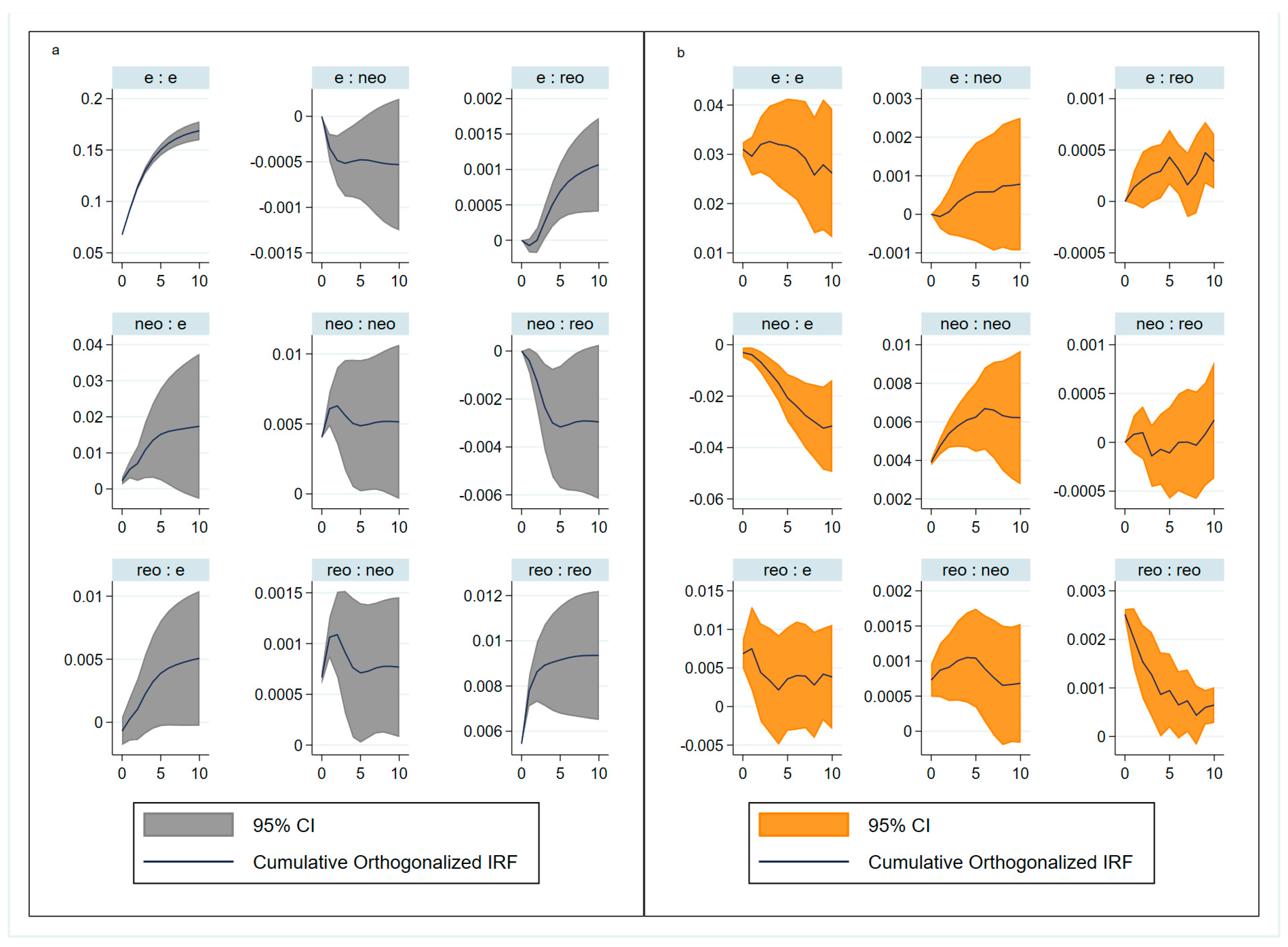
References
- Tang, Z.; Shi, C.B.; Liu, Z. Sustainable development of tourism industry in China under the low-carbon economy. Energy Procedia 2011, 5, 1303–1307. [Google Scholar] [CrossRef]
- Bridge, G.; Bouzarovski, S.; Bradshaw, M.; Eyre, N. Geographies of energy transition: Space, place and the low-carbon economy. Energy Policy 2013, 53, 331–340. [Google Scholar] [CrossRef]
- Cai, X.; Lu, Y.; Wu, M.; Yu, L. Does environmental regulation drive away inbound foreign direct investment? Evidence from a quasi-natural experiment in China. J. Dev. Econ. 2016, 123, 73–85. [Google Scholar] [CrossRef]
- Lyu, P.H.; Ngai, E.W.; Wu, P.Y. Scientific data-driven evaluation on academic articles of low-carbon economy. Energy Policy 2019, 125, 358–367. [Google Scholar] [CrossRef]
- Chen, J.; Gao, M.; Cheng, S.; Xu, Y.; Song, M.; Liu, Y.; Hou, W.; Wang, S. Evaluation and drivers of global low-carbon economies based on satellite data. Humanit. Soc. Sci. Commun. 2022, 9, 153. [Google Scholar] [CrossRef]
- Shahbaz, M.; Ozturk, I.; Afza, T.; Ali, A. Revisiting the environmental Kuznets curve in a global economy. Renew. Sustain. Energy Rev. 2013, 25, 494–502. [Google Scholar] [CrossRef]
- Schmidt, T.S. Low-carbon investment risks and de-risking. Nat. Clim. Change 2014, 44, 237–239. [Google Scholar] [CrossRef]
- Gao, M. The impacts of carbon trading policy on China’s low-carbon economy based on county-level perspectives. Energy Policy 2023, 175, 113494. [Google Scholar] [CrossRef]
- Talberth, J.; Bohara, A.K. Economic openness and green GDP. Ecol. Econ. 2006, 58, 743–758. [Google Scholar] [CrossRef]
- Van den Bergh, J.C.; Botzen, W.J.W. Monetary valuation of the social cost of CO2 emissions: A critical survey. Ecol. Econ. 2015, 114, 33–46. [Google Scholar] [CrossRef]
- Vaghefi, N.; Siwar, C.; Aziz, S.A.A.G. Green GDP and sustainable development in Malaysia. Curr. World Environ. 2015, 101, 1. [Google Scholar] [CrossRef]
- Kunanuntakij, K.; Varabuntoonvit, V.; Vorayos, N.; Panjapornpon, C.; Mungcharoen, T. Thailand Green GDP assessment based on environmentally extended input-output model. J. Clean. Prod. 2017, 167, 970–977. [Google Scholar] [CrossRef]
- Stjepanović, S.; Tomić, D.; Škare, M. A new approach to measuring green GDP: A cross-country analysis. Entrep. Sustain. Issues 2017, 4, 574. [Google Scholar] [CrossRef] [PubMed]
- Yang, C.; Poon, J.P. Regional Analysis of China’s Green GDP. Eurasian Geogr. Econ. 2009, 50, 547–563. [Google Scholar] [CrossRef]
- Zimmer, A.; Jakob, M.; Steckel, J.C. What motivates Vietnam to strive for a low-carbon economy?-On the drivers of climate policy in a developing country. Energy Sustain. Dev. 2015, 24, 19–32. [Google Scholar] [CrossRef]
- Zhang, Y.; Shen, L.; Shuai, C.; Tan, Y.; Ren, Y.; Wu, Y. Is the low-carbon economy efficient in terms of sustainable development? A global perspective. Sustain. Dev. 2019, 27, 130–152. [Google Scholar] [CrossRef]
- Liu, Y.; Wang, M.; Feng, C. Inequalities of China’s regional low-carbon development. J. Environ. Manag. 2020, 274, 111042. [Google Scholar] [CrossRef]
- Wu, S.; Han, H. Sectoral changing patterns of China’s green GDP considering climate change: An investigation based on the economic input-output life cycle assessment model. J. Clean. Prod. 2020, 251, 119764. [Google Scholar] [CrossRef]
- Zheng, J.; Shao, X.; Liu, W.; Kong, J.; Zuo, G. The impact of the pilot program on industrial structure upgrading in low-carbon cities. J. Clean. Prod. 2021, 290, 125868. [Google Scholar] [CrossRef]
- Grossman, G.M.; Krueger, A.B. Economic growth and the environment. Q. J. Econ. 1995, 1102, 353–377. [Google Scholar] [CrossRef]
- Chen, J.; Xu, C.; Cui, L.; Huang, S.; Song, M. Driving factors of CO2 emissions and inequality characteristics in China: A combined decomposition approach. Energy Econ. 2019, 78, 589–597. [Google Scholar] [CrossRef]
- Shan, Y.; Fang, S.; Cai, B.; Zhou, Y.; Li, D.; Feng, K.; Hubacek, K. Chinese cities exhibit varying degrees of decoupling of economic growth and CO2 emissions between 2005 and 2015. One Earth 2021, 41, 124–134. [Google Scholar] [CrossRef]
- Shang, L.; Xu, P. Can Carbon Emission Regulation Achieve a Dual Target of Low Carbon and Employment? An Empirical Analysis Based on China’s Provincial Panel Data. Front. Energy Res. 2022, 10, 926443. [Google Scholar] [CrossRef]
- Campiglio, E. Beyond carbon pricing: The role of banking and monetary policy in financing the transition to a low-carbon economy. Ecol. Econ. 2016, 121, 220–230. [Google Scholar] [CrossRef]
- Wu, Y.; Zhu, Q.; Zhu, B. Comparisons of decoupling trends of global economic growth and energy consumption between developed and developing countries. Energy Policy 2018, 116, 30–38. [Google Scholar] [CrossRef]
- Mardani, A.; Streimikiene, D.; Cavallaro, F.; Loganathan, N.; Khoshnoudi, M. Carbon dioxide CO2 emissions and economic growth: A systematic review of two decades of research from 1995 to 2017. Sci. Total Environ. 2019, 649, 31–49. [Google Scholar] [CrossRef]
- Li, G.; Wei, W. Financial development, openness, innovation, carbon emissions, and economic growth in China. Energy Econ. 2021, 97, 105194. [Google Scholar] [CrossRef]
- Sharif, F.; Tauqir, A. The effects of infrastructure development and carbon emissions on economic growth. Environ. Sci. Pollut. Res. 2021, 28, 36259–36273. [Google Scholar] [CrossRef] [PubMed]
- Lu, Q.; Yang, H.; Huang, X.; Chuai, X.; Wu, C. Multi-sectoral decomposition in decoupling industrial growth from carbon emissions in the developed Jiangsu Province, China. Energy 2015, 82, 414–425. [Google Scholar] [CrossRef]
- Hang, Y.; Wang, Q.; Zhou, D.; Zhang, L. Factors influencing the progress in decoupling economic growth from carbon dioxide emissions in China’s manufacturing industry. Resour. Conserv. Recycl. 2019, 146, 77–88. [Google Scholar] [CrossRef]
- Zhang, Z. Asian energy and environmental policy: Promoting growth while preserving the environment. Energy Policy 2008, 3610, 3905–3924. [Google Scholar] [CrossRef]
- Hu, Y.; Liu, J.; Ahmed, M. Does emission trading policy restrain economy? A county-scale empirical assessment from Zhejiang Province of China. Energy Policy 2022, 168, 113138. [Google Scholar] [CrossRef]
- Ziaei, S.M. Effects of financial development indicators on energy consumption and CO2 emission of European, East Asian and Oceania countries. Renew. Sustain. Energy Rev. 2015, 42, 752–759. [Google Scholar] [CrossRef]
- Adams, S.; Klobodu, E.K.M.; Opoku, E.E.O. Energy consumption, political regime and economic growth in sub-Saharan Africa. Energy Policy 2016, 96, 36–44. [Google Scholar] [CrossRef]
- Antonakakis, N.; Chatziantoniou, I.; Filis, G. Energy consumption, CO2 emissions, and economic growth: An ethical dilemma. Renew. Sustain. Energy Rev. 2017, 68, 808–824. [Google Scholar] [CrossRef]
- Pan, W.; Pan, W.; Hu, C.; Tu, H.; Zhao, C.; Yu, D.; Xiong, J.; Zheng, G. Assessing the green economy in China: An improved framework. J. Clean. Prod. 2019, 209, 680–691. [Google Scholar] [CrossRef]
- Al-Mulali, U. Investigating the impact of nuclear energy consumption on GDP growth and CO2 emission: A panel data analysis. Prog. Nucl. Energy 2014, 73, 172–178. [Google Scholar] [CrossRef]
- Rajbhandari, A.; Zhang, F. Does energy efficiency promote economic growth? Evidence from a multicountry and multisectoral panel dataset. Energy Econ. 2018, 69, 128–139. [Google Scholar] [CrossRef]
- Chen, J.; Liu, J.; Qi, J.; Gao, M.; Cheng, S.; Li, K.; Xu, C. City- county-level spatio-temporal energy consumption and efficiency datasets for China from 1997 to 2017. Sci. Data 2022, 91, 101. [Google Scholar] [CrossRef]
- Cheng, Z.; Li, L.; Liu, J. Industrial structure, technical progress and carbon intensity in China’s provinces. Renew. Sustain. Energy Rev. 2018, 81, 2935–2946. [Google Scholar] [CrossRef]
- Huang, J.; Liu, Q.; Cai, X.; Hao, Y.; Lei, H. The effect of technological factors on China’s carbon intensity: New evidence from a panel threshold model. Energy Policy 2018, 115, 32–42. [Google Scholar] [CrossRef]
- Tapio, P. Towards a theory of decoupling: Degrees of decoupling in the EU and the case of road traffic in Finland between 1970 and 2001. Transp. Policy 2005, 122, 137–151. [Google Scholar] [CrossRef]
- Coderoni, S.; Esposti, R. CAP payments and agricultural GHG emissions in Italy. A farm-level assessment. Sci. Total Environ. 2018, 627, 427–437. [Google Scholar] [CrossRef]
- Srivastava, A.; Van Passel, S.; Kessels, R.; Valkering, P.; Laes, E. Reducing winter peaks in electricity consumption: A choice experiment to structure demand response programs. Energy Policy 2020, 137, 111183. [Google Scholar] [CrossRef]
- Yang, M.; Wang, E.Z.; Hou, Y. The relationship between manufacturing growth and CO2 emissions: Does renewable energy consumption matter? Energy 2021, 232, 121032. [Google Scholar] [CrossRef]
- Liu, F.; Kang, Y.; Guo, K. Is electricity consumption of Chinese counties decoupled from carbon emissions? A study based on Tapio decoupling index. Energy 2022, 251, 123879. [Google Scholar] [CrossRef]
- Pan, X.; Li, M.; Guo, S.; Pu, C. Research on the competitive effect of local government’s environmental expenditure in China. Sci. Total Environ. 2020, 718, 137238. [Google Scholar] [CrossRef] [PubMed]
- Kou, J.; Xu, X. Does internet infrastructure improve or reduce carbon emission performance?--A dual perspective based on local government intervention and market segmentation. J. Clean. Prod. 2022, 379, 134789. [Google Scholar] [CrossRef]
- Yan, Y.; Huang, J. The role of population agglomeration played in China’s carbon intensity: A city-level analysis. Energy Econ. 2022, 114, 106276. [Google Scholar] [CrossRef]
- Pollitt, M.G. A global carbon market? Front. Eng. Manag. 2019, 6, 5–18. [Google Scholar] [CrossRef]
- Chen, X.; Nordhaus, W.D. Using luminosity data as a proxy for economic statistics. Proc. Natl. Acad. Sci. USA 2011, 108, 8589–8594. [Google Scholar] [CrossRef] [PubMed]
- Henderson, J.; Vernon, A.S.; Weil, D.N. Measuring economic growth from outer space. Am. Econ. Rev. 2012, 102, 994–1028. [Google Scholar] [CrossRef] [PubMed]
- Hu, Y.; Yao, J. Illuminating economic growth. J. Econ. 2021, 228, 359–378. [Google Scholar] [CrossRef]
- Dong, F.; Dai, Y.; Zhang, S.; Zhang, X.; Long, R. Can a carbon emission trading scheme generate the Porter effect? Evidence from pilot areas in China. Sci. Total Environ. 2019, 653, 565–577. [Google Scholar] [CrossRef] [PubMed]
- Cheng, S.; Fan, W.; Meng, F.; Chen, J.; Liang, S.; Song, M.; Liu, G.; Casazza, M. Potential role of fiscal decentralization on interprovincial differences in CO2 emissions in China. Environ. Sci. Technol. 2020, 55, 813–822. [Google Scholar] [CrossRef]
- Jones, M.W.; Andrew, R.M.; Peters, G.P.; Janssens-Maenhout, G.; De-Gol, A.J.; Ciais, P.; Patra, P.K.; Chevallier, F.; Le Quéré, C. Gridded fossil CO2 emissions and related O2 combustion consistent with national inventories 1959–2018. Sci. Data 2021, 8, 2. [Google Scholar] [CrossRef]
- Harris, N.L.; Gibbs, D.A.; Baccini, A.; Birdsey, R.A.; de Bruin, S.; Farina, M.; Fatoyinbo, L.; Hansen, M.C.; Herold, M.; Houghton, R.A.; et al. Global maps of twenty-first century forest carbon fluxes. Nat. Clim. Change 2021, 11, 234–240. [Google Scholar] [CrossRef]
- Lv, Q.; Liu, H.; Wang, J.; Liu, H.; Shang, Y. Multiscale analysis on spatiotemporal dynamics of energy consumption CO2 emissions in China: Utilizing the integrated of DMSP-OLS and NPP-VIIRS nighttime light datasets. Sci. Total Environ. 2020, 703, 134394. [Google Scholar] [CrossRef]
- Chen, J.; Gao, M.; Cheng, S.; Hou, W.; Song, M.; Liu, X.; Liu, Y. Global 1 km × 1 km gridded revised real gross domestic product and electricity consumption during 1992–2019 based on calibrated nighttime light data. Sci. Data 2022, 9, 202. [Google Scholar] [CrossRef]
- Cai, S.; Liu, D.; Sulla-Menashe, D.; Friedl, M.A. Enhancing MODIS land cover product with a spatial–temporal modeling algorithm. Remote Sens. Environ. 2014, 147, 243–255. [Google Scholar] [CrossRef]
- He, S.; Li, J.; Wang, J.; Liu, F. Evaluation and analysis of upscaling of different land use/land cover products FORM-GLC30, GLC_FCS30, CCI_LC, MCD12Q1 and CNLUCC: A case study in China. Geocarto Int. 2022, 37, 17340–17360. [Google Scholar] [CrossRef]
- Zhao, M.; Running, S.W. Drought-induced reduction in global terrestrial net primary production from 2000 through 2009. Science 2010, 3295994, 940–943. [Google Scholar] [CrossRef] [PubMed]
- Choi, I. Unit root tests for panel data. J. Int. Money Fin. 2001, 20, 249–272. [Google Scholar] [CrossRef]
- Dinda, S. Environmental Kuznets curve hypothesis: A survey. Ecol. Econ. 2004, 494, 431–455. [Google Scholar] [CrossRef]
- Dinda, S. A theoretical basis for the environmental Kuznets curve. Ecol. Econ. 2005, 533, 403–413. [Google Scholar] [CrossRef]
- Gu, W.; Zhao, X.; Yan, X.; Wang, C.; Li, Q. Energy technological progress, energy consumption, and CO2 emissions: Empirical evidence from China. J. Clean. Prod. 2019, 236, 117666. [Google Scholar] [CrossRef]
- Li, D.; Gao, M.; Hou, W.; Song, M.; Chen, J. A modified and improved method to measure economy-wide carbon rebound effects based on the PDA-MMI approach. Energy Policy 2020, 147, 111862. [Google Scholar] [CrossRef]
- Meng, Y.; Liu, L.; Wang, J.; Ran, Q.; Yang, X.; Shen, J. Assessing the impact of the national sustainable development planning of resource-based cities policy on pollution emission intensity: Evidence from 270 prefecture-level cities in China. Sustainability 2021, 1313, 7293. [Google Scholar] [CrossRef]
- Yu, C.; Li, H.; Jia, X.; Li, Q. Improving resource utilization efficiency in China’s mineral resource-based cities: A case study of Chengde, Hebei province. Resour. Conserv. Recycl. 2015, 94, 1–10. [Google Scholar] [CrossRef]
- Yu, B.; Fang, D.; Kleit, A.N.; Xiao, K. Exploring the driving mechanism and the evolution of the low-carbon economy transition: Lessons from OECD developed countries. World Econ. 2022, 45, 2766–2795. [Google Scholar] [CrossRef]
- Zhang, F.; Deng, X.; Phillips, F.; Fang, C.; Wang, C. Impacts of industrial structure and technical progress on carbon emission intensity: Evidence from 281 cities in China. Technol. Forecast. Soc. Change 2020, 154, 119949. [Google Scholar] [CrossRef]
- Li, X.; Li, C.; Guo, X. Environmental practices, family control, and corporate performance: Evidence from Chinese family firms. Emerg. Mark. Rev. 2022, 55, 100953. [Google Scholar] [CrossRef]
- Pan, X.; Guo, S.; Xu, H.; Tian, M.; Pan, X.; Chu, J. China’s carbon intensity factor decomposition and carbon emission decoupling analysis. Energy 2022, 239, 122175. [Google Scholar] [CrossRef]
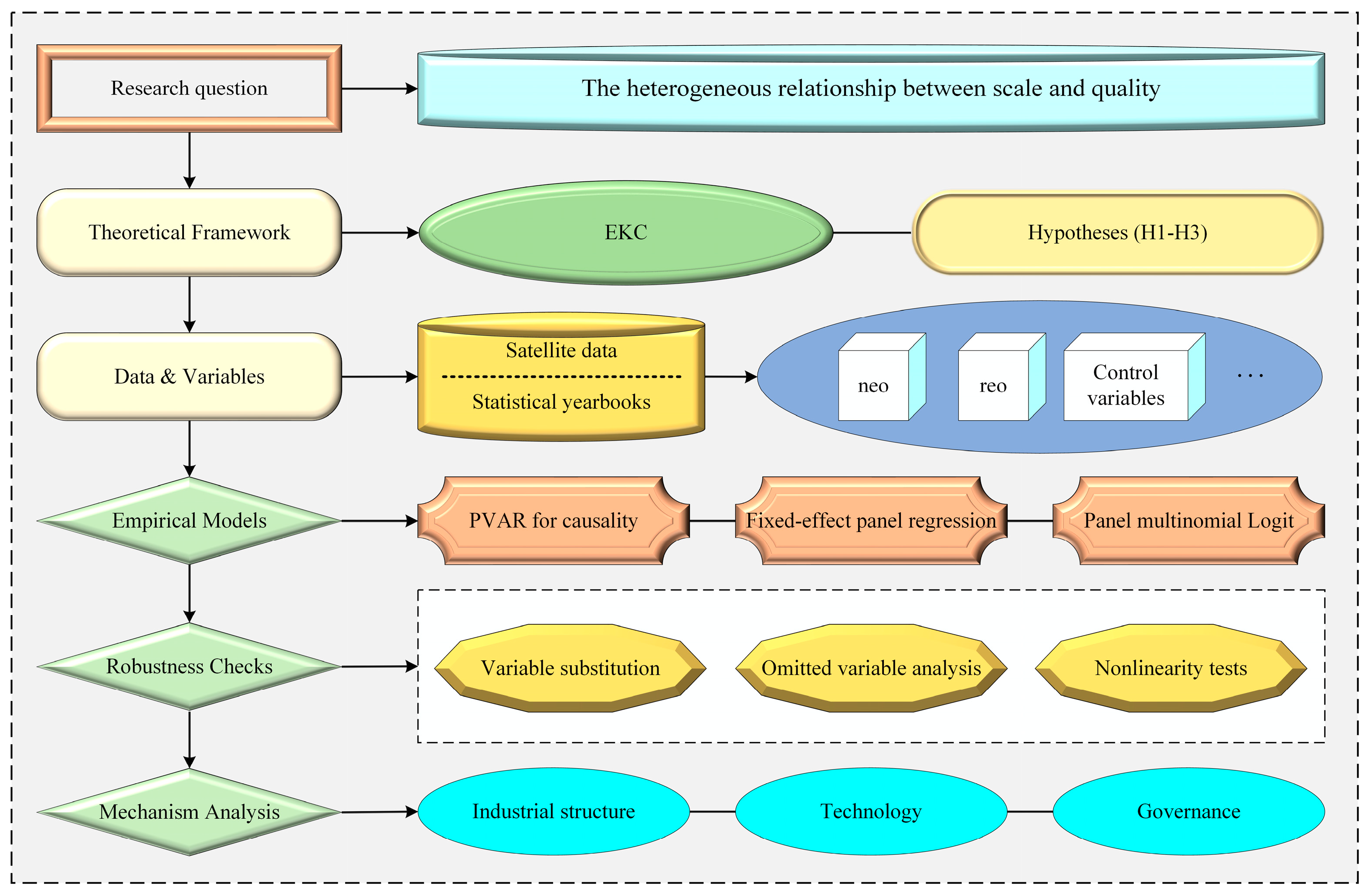
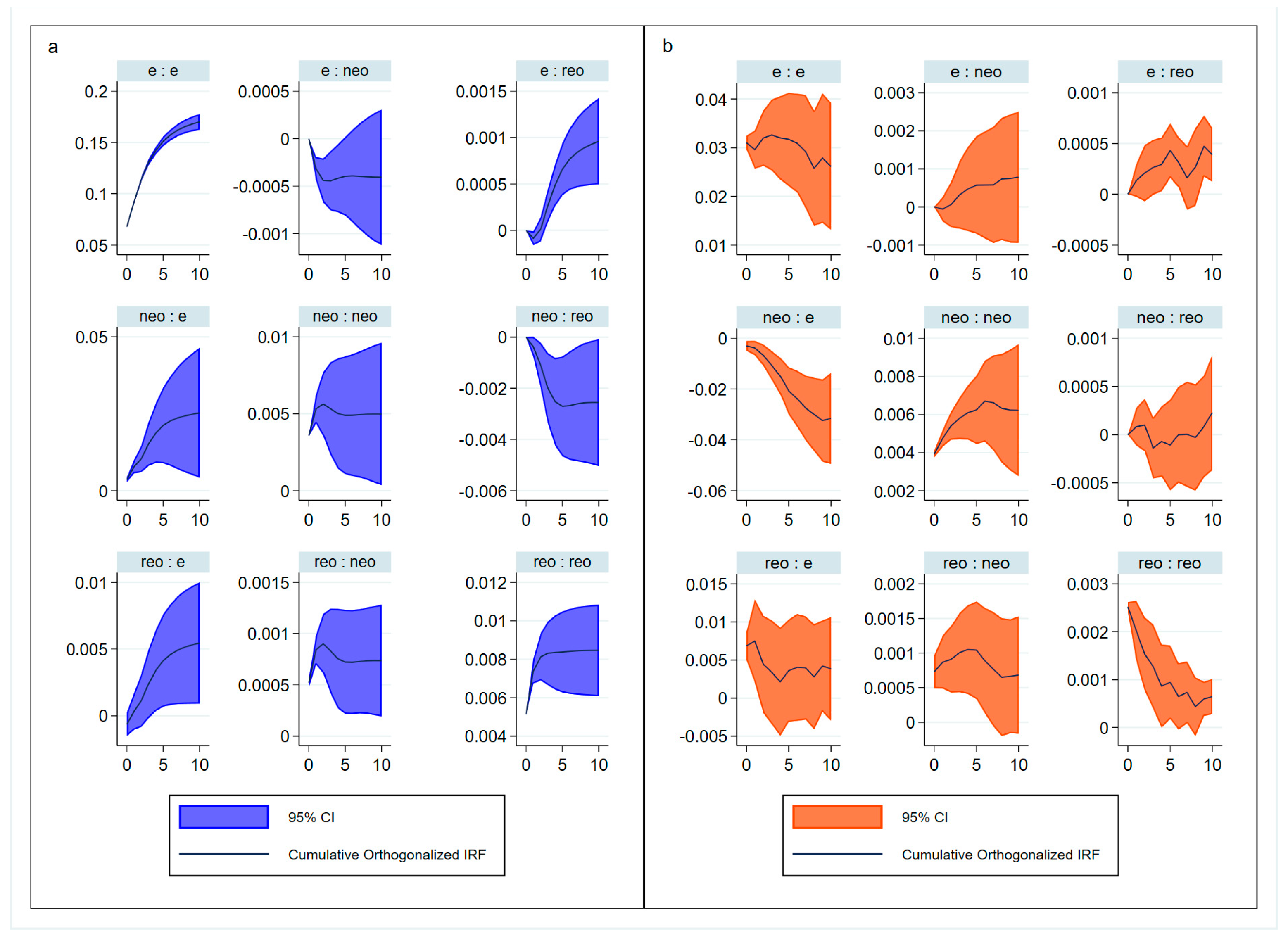


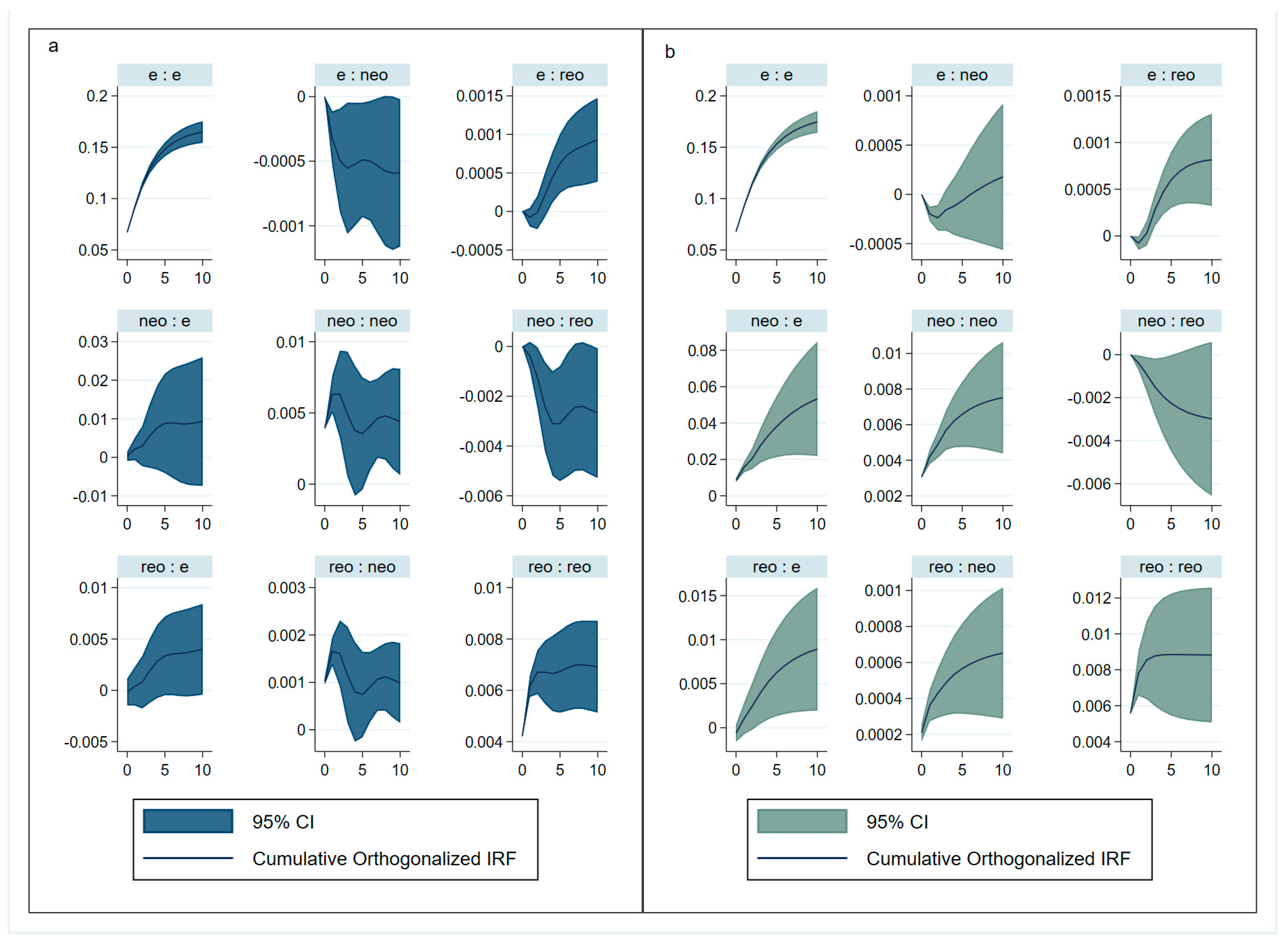


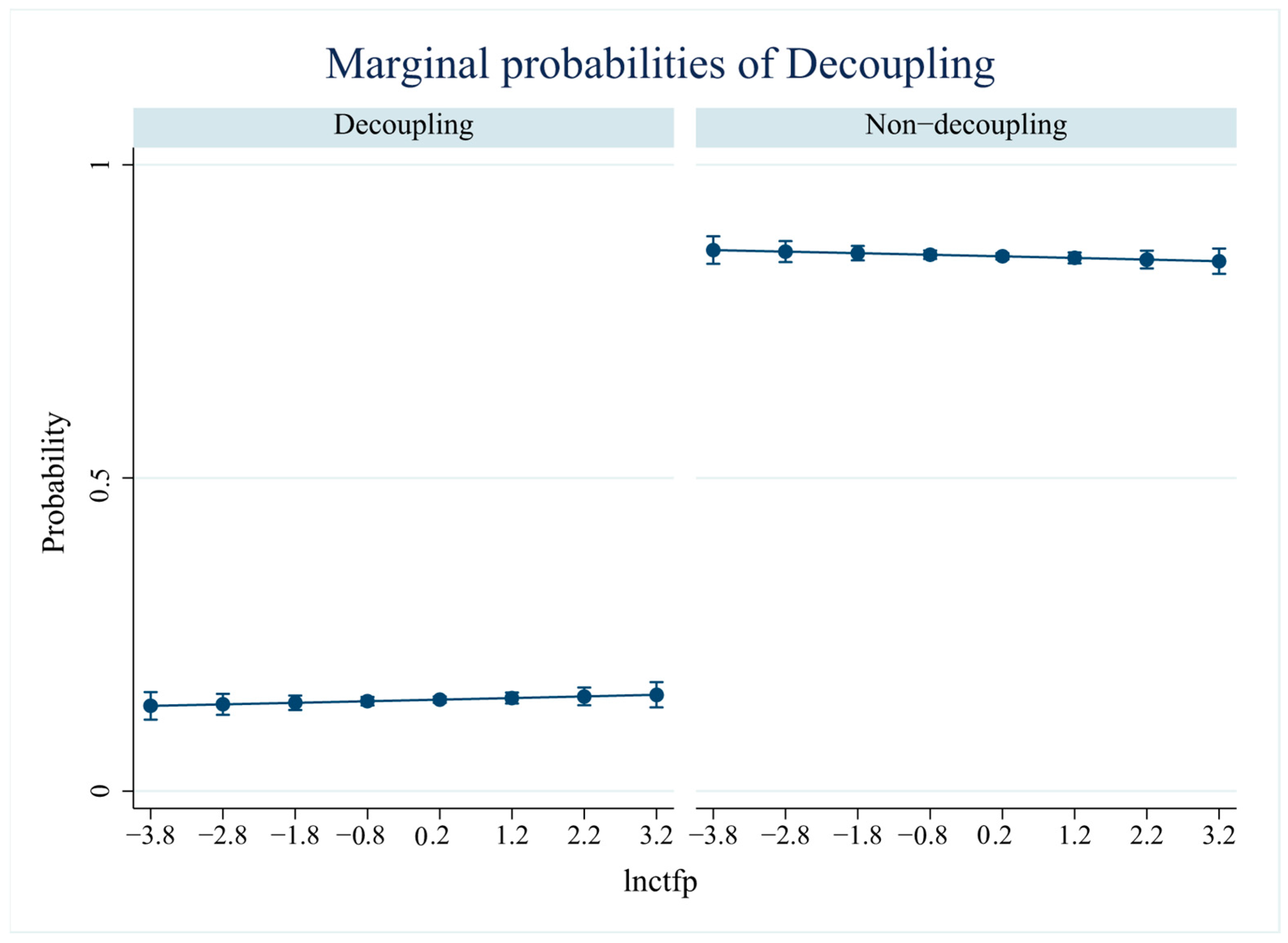
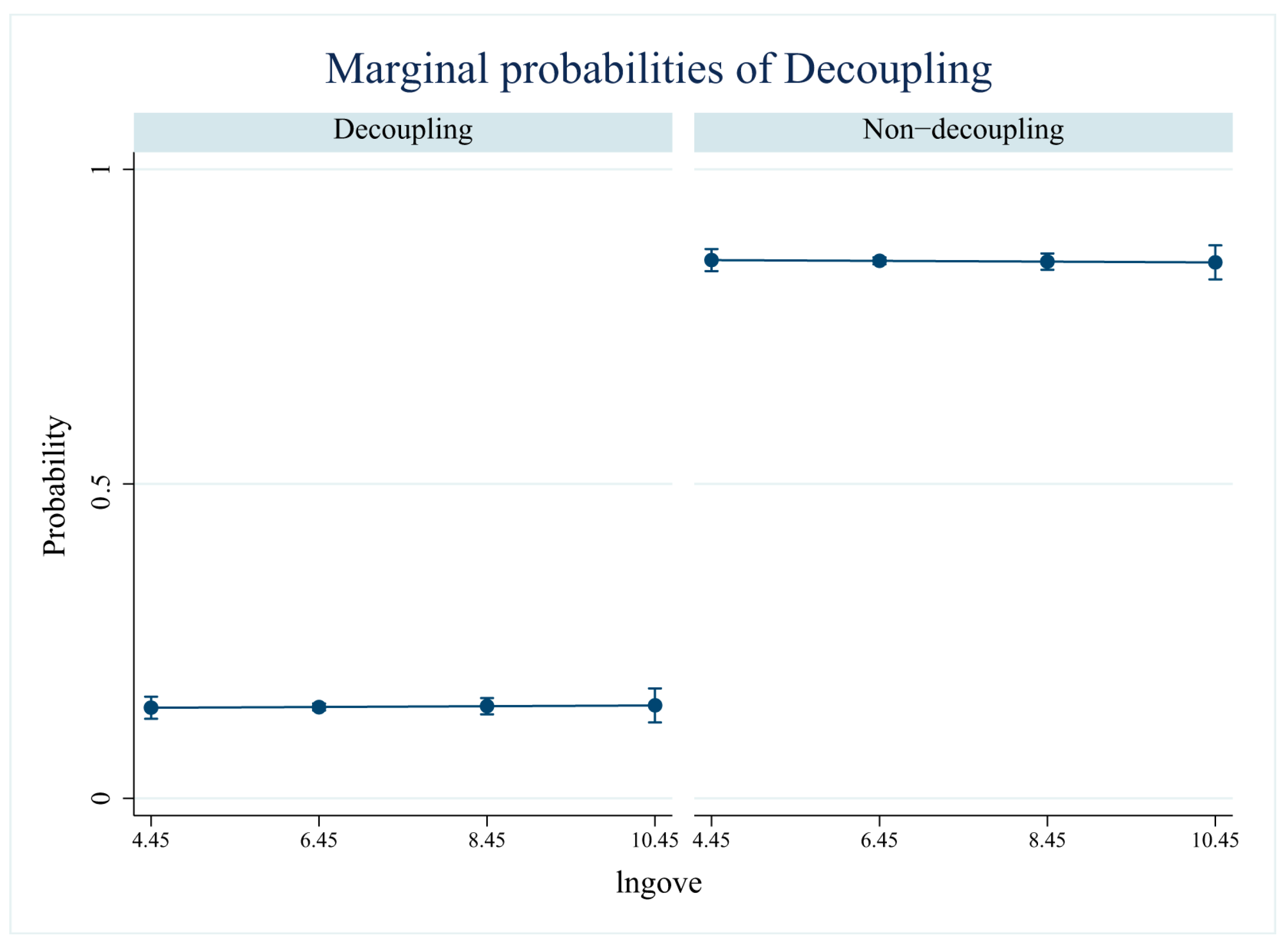
| Region | Variables | IPS Test | LLC Test |
|---|---|---|---|
| Counties | dln(reo) | −55.29 *** | −72.54 *** |
| dln(neo) | −56.30 *** | −110 *** | |
| dln(e) | −53.07 *** | −45.05 *** | |
| Municipal districts | dln(reo) | −25.65 *** | −300 *** |
| dln(neo) | −26.18 *** | −62.21 *** | |
| dln(e) | −23.70 *** | −10.07 *** |
| (1) | (2) | (3) | (4) | |
|---|---|---|---|---|
| ln(reo) | ln(reo) | ln(reo) | ln(reo) | |
| Counties | Municipal districts | Counties with high quartiles of ln(ce) | Counties with high quartiles of ln(is) | |
| ln(neo) | −0.4296 *** | −1.8998 *** | −0.0465 | 0.3654 |
| (0.0694) | (0.5676) | (0.1466) | (1.3301) | |
| ln(neo2) | 0.0215 *** | 0.1038 *** | −0.0083 | −0.0257 |
| (0.0048) | (0.0321) | (0.0116) | (0.0816) | |
| Control variables | Yes | Yes | Yes | Yes |
| Lower bound slope | −0.18 | −0.72 *** | −0.14 | 0.075 |
| Upper bound slope | −0.0006 | 0.17 ** | −0.21 | −0.14 |
| Individual FE | Yes | Yes | Yes | Yes |
| Year FE | Yes | Yes | Yes | Yes |
| R2 | 0.1200 | 0.2051 | 0.3560 | 0.3368 |
| N | 12,616 | 3056 | 3157 | 2929 |
| (1) | (2) | (3) | (4) | |
|---|---|---|---|---|
| ln(reo) | ln(reo) | ln(reo) | ln(reo) | |
| Counties | Municipal districts | Counties | Municipal districts | |
| ln(is1) | −0.0063 ** | −0.0211 | ||
| (0.0026) | (0.0138) | |||
| ln(is2) | −0.0026 ** | −0.0013 | ||
| (0.0011) | (0.0070) | |||
| Control variables | Yes | Yes | Yes | Yes |
| Individual FE | Yes | Yes | Yes | Yes |
| Year FE | Yes | Yes | Yes | Yes |
| R2 | 0.1055 | 0.1293 | 0.1030 | 0.1192 |
| N | 12,616 | 3056 | 9768 | 2546 |
| (1) | (2) | |
|---|---|---|
| ln(reo) | ln(reo) | |
| Counties | Municipal districts | |
| i.tapio#c.ln(ctfp) | 0.0245 | 0.0065 *** |
| (0.0222) | (0.0020) | |
| Control variables | Yes | Yes |
| Individual FE | Yes | Yes |
| Year FE | Yes | Yes |
| R2 | 0.1072 | 0.1783 |
| N | 12,616 | 3056 |
| (1) | (2) | (3) | (4) | (5) | (6) | |
|---|---|---|---|---|---|---|
| ln(reo) | ln(reo) | ln(reo) | ln(reo) | ln(reo) | ln(reo) | |
| Counties with high quartiles of ln(ce) | Municipal districts with high quartiles of ln(ce) | Counties with high quartiles of ln(is) | Municipal districts with high quartiles of ln(is) | Counties with high quartiles of ln(ii) | Municipal districts with high quartiles of ln(ii) | |
| i.tapio#c.ln(ctfp) | 0.0181 | 0.0093 *** | 0.0255 | 0.0088 *** | 0.0281 | 0.0035 *** |
| (0.0286) | (0.0035) | (0.0178) | (0.0033) | (0.0409) | (0.0013) | |
| Control variables | Yes | Yes | Yes | Yes | Yes | Yes |
| Individual FE | Yes | Yes | Yes | Yes | Yes | Yes |
| Year FE | Yes | Yes | Yes | Yes | Yes | Yes |
| R2 | 0.3045 | 0.2968 | 0.3280 | 0.2144 | 0.0885 | 0.1306 |
| N | 3157 | 1078 | 2929 | 1021 | 5281 | 1559 |
| (1) | (2) | |
|---|---|---|
| ln(reo) | ln(reo) | |
| Counties | Municipal districts | |
| i.tapio#c.ln(gove) | 0.0025 | 0.0106 *** |
| (0.0015) | (0.0030) | |
| Control variables | Yes | Yes |
| Individual FE | Yes | Yes |
| Year FE | Yes | Yes |
| R2 | 0.1094 | 0.1808 |
| N | 12,616 | 3056 |
| (1) | (2) | (3) | (4) | (5) | (6) | |
|---|---|---|---|---|---|---|
| ln(reo) | ln(reo) | ln(reo) | ln(reo) | ln(reo) | ln(reo) | |
| Counties with high quartiles of ln(ce) | Municipal districts with high quartiles of ln(ce) | Counties with high quartiles of ln(is) | Municipal districts with high quartiles of ln(is) | Counties with high quartiles of ln(ii) | Municipal districts with high quartiles of ln(ii) | |
| i.tapio#c.ln(gove) | 0.0024 ** | 0.0178 *** | 0.0007 | 0.0122 *** | 0.0016 ** | 0.0069 *** |
| (0.0011) | (0.0064) | (0.0005) | (0.0038) | (0.0007) | (0.0019) | |
| Control variables | Yes | Yes | Yes | Yes | Yes | Yes |
| Individual FE | Yes | Yes | Yes | Yes | Yes | Yes |
| Year FE | Yes | Yes | Yes | Yes | Yes | Yes |
| R2 | 0.3045 | 0.2968 | 0.3280 | 0.2144 | 0.0885 | 0.1306 |
| N | 3157 | 1078 | 2929 | 1021 | 5281 | 1559 |
Disclaimer/Publisher’s Note: The statements, opinions and data contained in all publications are solely those of the individual author(s) and contributor(s) and not of MDPI and/or the editor(s). MDPI and/or the editor(s) disclaim responsibility for any injury to people or property resulting from any ideas, methods, instructions or products referred to in the content. |
© 2025 by the authors. Licensee MDPI, Basel, Switzerland. This article is an open access article distributed under the terms and conditions of the Creative Commons Attribution (CC BY) license (https://creativecommons.org/licenses/by/4.0/).
Share and Cite
Yang, Z.; Chen, X.; Chen, J.; Gao, M. The Heterogeneous Relationship Between China’s Low-Carbon Economic Scale and Quality: A County-Level Analysis from the Perspective of Administrative Division. Sustainability 2025, 17, 3572. https://doi.org/10.3390/su17083572
Yang Z, Chen X, Chen J, Gao M. The Heterogeneous Relationship Between China’s Low-Carbon Economic Scale and Quality: A County-Level Analysis from the Perspective of Administrative Division. Sustainability. 2025; 17(8):3572. https://doi.org/10.3390/su17083572
Chicago/Turabian StyleYang, Zhixing, Xingyu Chen, Jiandong Chen, and Ming Gao. 2025. "The Heterogeneous Relationship Between China’s Low-Carbon Economic Scale and Quality: A County-Level Analysis from the Perspective of Administrative Division" Sustainability 17, no. 8: 3572. https://doi.org/10.3390/su17083572
APA StyleYang, Z., Chen, X., Chen, J., & Gao, M. (2025). The Heterogeneous Relationship Between China’s Low-Carbon Economic Scale and Quality: A County-Level Analysis from the Perspective of Administrative Division. Sustainability, 17(8), 3572. https://doi.org/10.3390/su17083572






